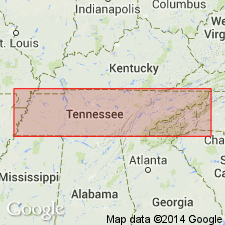
- Usage in publication:
-
- Ridgetop shale
- Modifications:
-
- Named
- Dominant lithology:
-
- Shale
- AAPG geologic province:
-
- Cincinnati arch
Summary:
Ridgetop shale (new) underlies Fort Payne chert and overlies Maury green shale. Locally developed along north and west sides of Nashville dome. In section along Louisville and Nashville RR from Bakers to Ridgetop, the formation consists of (descending): 1) 15 to 20 ft of light-blue to green clay shale with many ostracodes and brachiopods; 2) 2 ft of arenaceous shale with bands of porous chert, yielding silicified fossils; 3) 36 ft of light-blue to green shale with same fossils as in No. 1; 4) 4 ft of unfossiliferous blue shale 5) 5 ft of thin-bedded argillaceous limestone and compact dark shale with many fossils; 6) 15 ft of dark compact clay shale with few fossils; 7) 1 ft of fine-grained argillaceous sandstone weathering red and forming a conspicuous line in the section; 8) 20 ft of light-blue to green unfossiliferous shale; and 9) 1 ft of sandy unfossiliferous chert. All of these beds were included in Tullahoma by Safford and Killebrew and by Hayes and Ulrich, but they represent a distinct group--the Kinderhook--and hence the new name Ridgetop shale is proposed. In section 12 mi north of Nashville, 35 ft of New Providence formation intervenes between Ridgetop shale and Fort Payne chert.
Source: GNU records (USGS DDS-6; Reston GNULEX).

- Usage in publication:
-
- Ridgetop shale
- Modifications:
-
- First used
- AAPG geologic province:
-
- Cincinnati arch
Summary:
Unit shown on plate 29 as overlying Chattanooga shale and unconformably underlying New Providence formation.
Source: GNU records (USGS DDS-6; Reston GNULEX).
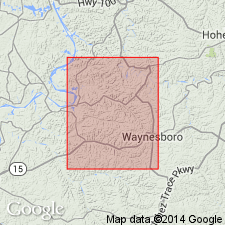
- Usage in publication:
-
- Ridgetop shale
- Modifications:
-
- Revised
- AAPG geologic province:
-
- Cincinnati arch
Summary:
Maury glauconitic member included in base of Ridgetop shale of Waynesboro quad. The Maury is a thin bed closely associated with overlying shale and carrying similar fossils. There is some question whether the Ridgetop of Hardin Co. is of same age as typical Ridgetop.
Source: GNU records (USGS DDS-6; Reston GNULEX).
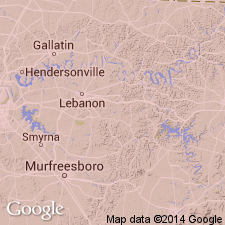
- Usage in publication:
-
- Ridgetop shale
- Modifications:
-
- Revised
- AAPG geologic province:
-
- Cincinnati arch
Summary:
Recent study of the type section of the Ridgetop shale revealed that upper 30 ft of supposed Ridgetop held the bryozoan fauna of New Providence shale. These New Providence beds consists of blue calcareous shale with occasional thin argillaceous limestone bands with 2 ft of sandy layers at base, and they are here referred to New Providence shale. The Ridgetop shale is therefore restricted to the beds below. The Ridgetop, as it is revised, consists of (descending) 1) 12 ft of gray-green shale becoming calcareous toward top; 2) 4 ft of blue-green to gray-green soft shale with 6-in. glauconite band at top and at base; 3) 10 ft of gray-green siliceous shale; 4) 1 to 2 ft of siliceous limestone with conchoidal fracture weathering yellow and containing Ostracoda; 5) 20 ft of calcareous green and finely sandy gray-green shale with a few geodes in upper half and ostracodes in several layers; 6) 1 to 1.3 ft of yellow platy chert with fossils; 7) 0.5 to 1 ft of green shale with phosphated nodules; and 8) 0.25 to 0.33 ft of green shale passing gradually downward into black Chattanooga shale.
Source: GNU records (USGS DDS-6; Reston GNULEX).
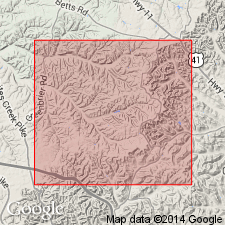
- Usage in publication:
-
- Ridgetop shale
- Modifications:
-
- Not used
- AAPG geologic province:
-
- Cincinnati arch
Summary:
From stratigraphic and paleontologic evidence, it is believed that "Ridgetop shale" is not a separate formation and that strata previously assigned to the "Ridgetop" are only a phase of the New Providence. If beds of Kinderhook age (other than probably the Chattanooga shale) are present in central TN, they are not represented in beds formerly separated as "Ridgetop shale."
Source: GNU records (USGS DDS-6; Reston GNULEX).
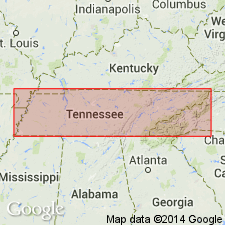
- Usage in publication:
-
- Ridgetop shale
- Modifications:
-
- Age modified
- AAPG geologic province:
-
- Cincinnati arch
Summary:
Faunal and stratigraphic studies show "Ridgetop Shale" to be a phase of New Providence formation and to be of Fern Glen, rather than Kinderhook age, as previously assigned. Of 22 species of invertebrates collected by writers from this shale at its type locality (Ridgetop Station), 21 commonly occur in Fern Glen or younger beds, and 3 occur also in the Kinderhook, but only 1 is typically Kinderhook. Detailed tracing of beds through the 5 mi between type locality of "Ridgetop shale" and the local type locality of New Providence formation shows that the drab-green and gray siltstones of the "Ridgetop" can be traced laterally into green shale and the local crinoidal limestone lenses of the New Providence. Similar lateral correlation has been made at other localities in central TN. The green shale, the local crinoidal limestone, and the drab siltstone (that was formerly separated as "Ridgetop") of New Providence formation contain fossils characteristic of each different facies, but all are predominantly of Fern Glen age.
Source: GNU records (USGS DDS-6; Reston GNULEX).
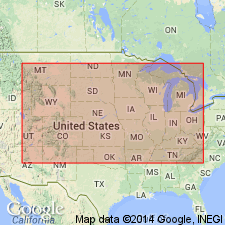
- Usage in publication:
-
- Ridgetop shale
- Modifications:
-
- Overview
- AAPG geologic province:
-
- Cincinnati arch
Summary:
New Providence and Ridgetop shales, as locally recognized, appear to be slightly different developments of beds of same age.
Source: GNU records (USGS DDS-6; Reston GNULEX).
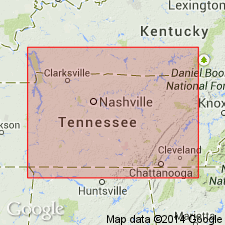
- Usage in publication:
-
- Ridgetop shale*
- Modifications:
-
- Revised
- AAPG geologic province:
-
- Cincinnati arch
Summary:
Author follows usage of Safford and Killebrew (1900) in restoring Maury to formation rank and removing it from overlying Ridgetop as a member.
Source: GNU records (USGS DDS-6; Reston GNULEX).
For more information, please contact Nancy Stamm, Geologic Names Committee Secretary.
Asterisk (*) indicates published by U.S. Geological Survey authors.
"No current usage" (†) implies that a name has been abandoned or has fallen into disuse. Former usage and, if known, replacement name given in parentheses ( ).
Slash (/) indicates name conflicts with nomenclatural guidelines (CSN, 1933; ACSN, 1961, 1970; NACSN, 1983, 2005, 2021). May be explained within brackets ([ ]).

